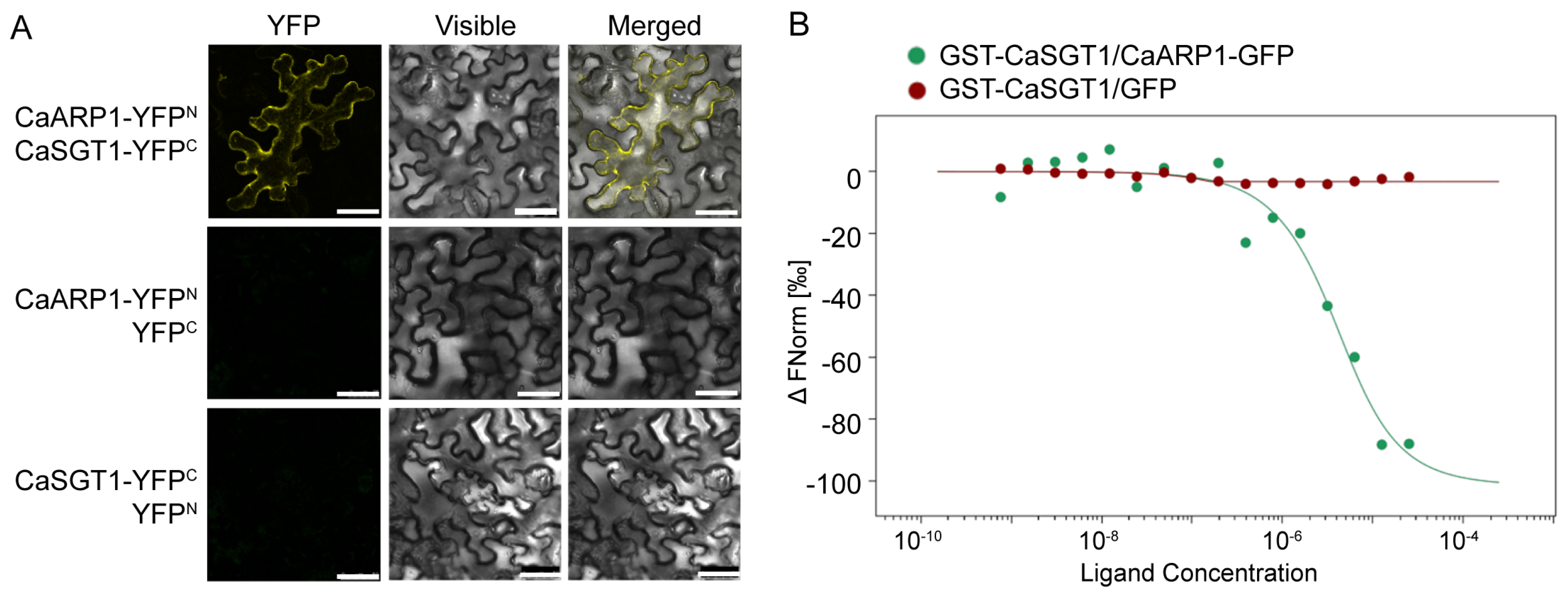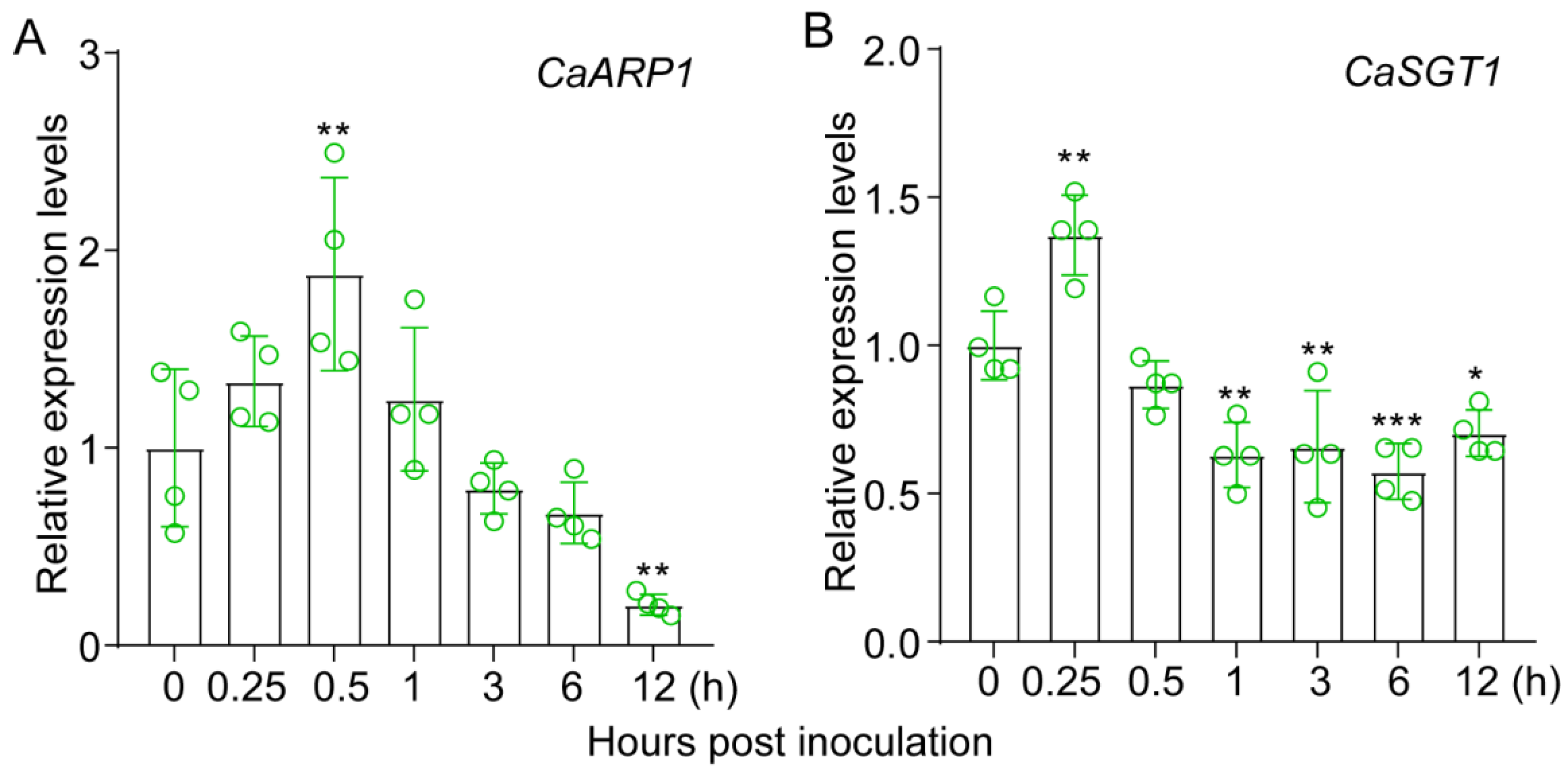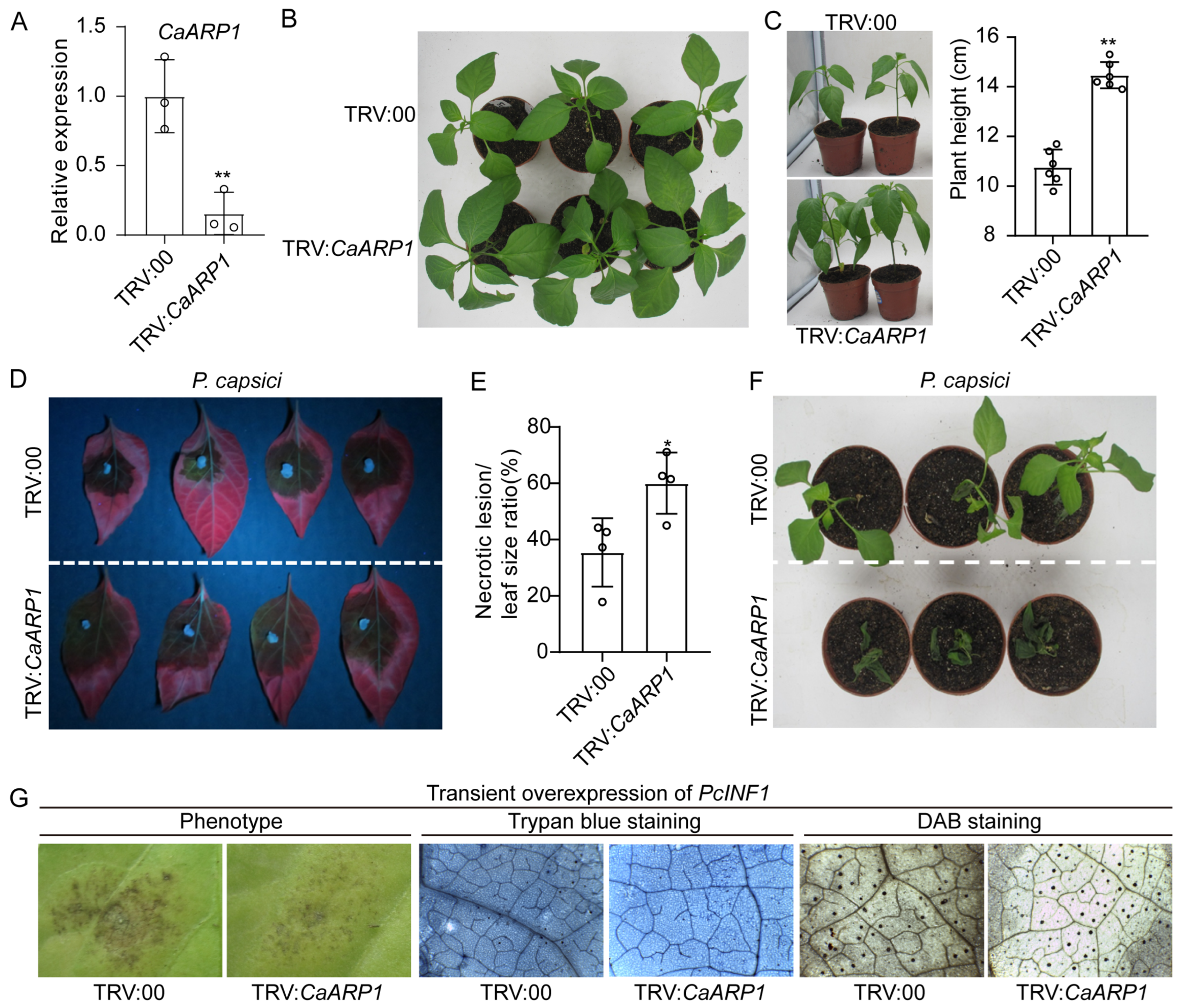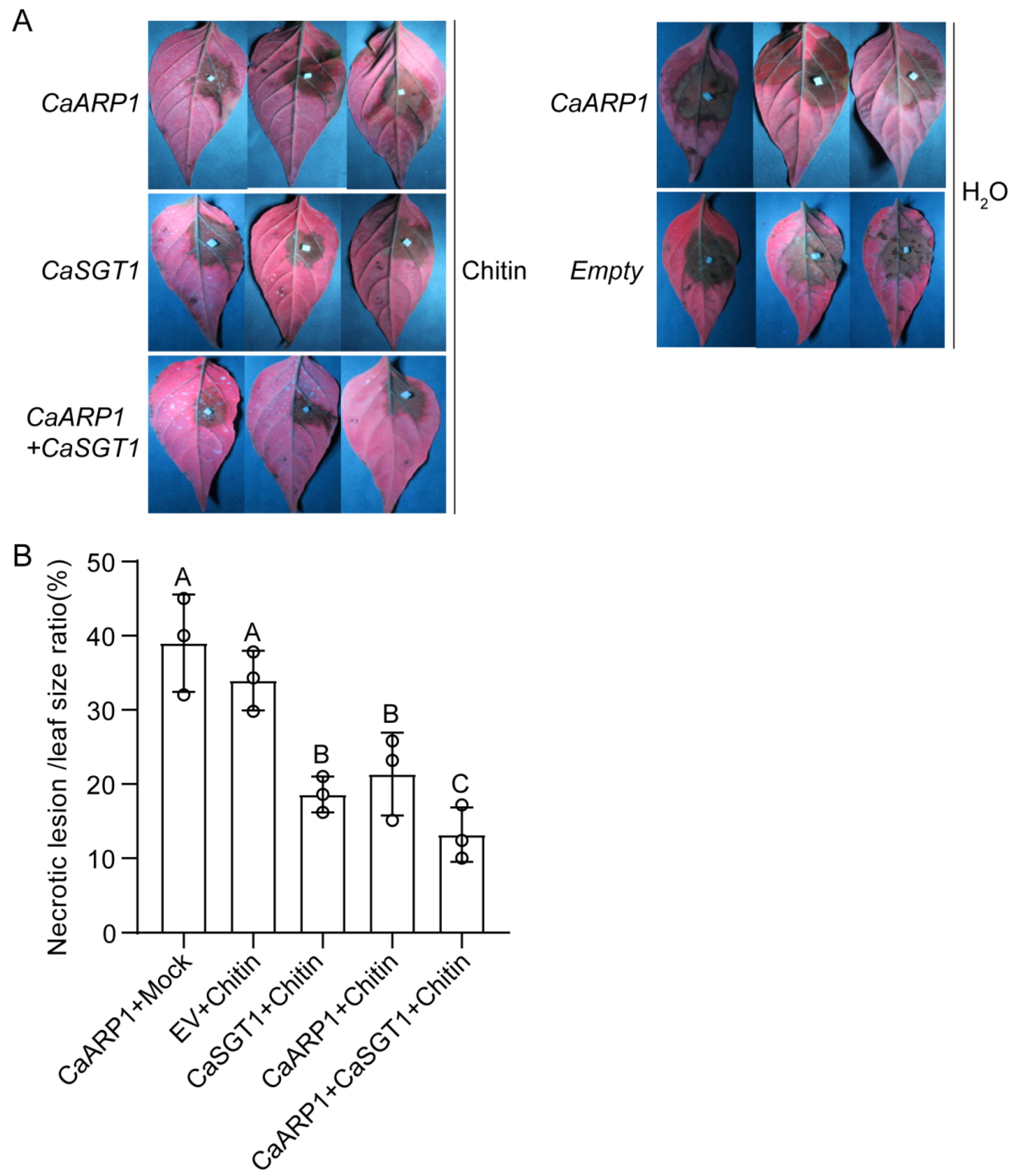1. Introduction
Pepper is one of the most economically valuable vegetables worldwide; however, it is also highly susceptible to oomycete diseases, particularly those caused by
Phytophthora capsici infection. This pathogen attacks various plant tissues, including roots, leaves, stems, and fruits. To manage crop diseases effectively, an integrated strategy is required, which includes appropriate cultural practices, judicious use of pesticides, and the development of resistant varieties. The creation of such resistant germplasm primarily hinges on the identification and integration of
resistance (
R) genes into superior cultivars via genetic crosses [
1].
In their natural habitats, plants frequently suffer from attacks by pathogens, which often lead to serious disease [
2,
3,
4]. To survive, plants utilize multiple strategies to fight against microbial attack, one of which is to avoid or minimize growth and activate the defense signal transduction. As an important class of phytohormones, auxin plays a crucial role in a wide variety of growth and development processes [
5], including stem elongation, establishment of embryonic polarity [
6], lateral branching of roots and shoots [
7], vegetative growth [
8], floral organogenesis [
9], differentiation of vascular tissue [
10], and seed production [
11]. A series of downstream genes were induced by the response to auxin and termed as the auxin responsive genes, which include
small auxin up RNA (
SAUR),
Gretchen Hagen3 (
Gh3),
Auxin/Indole-3-Acetic Acid (
Aux/IAA),
auxin responsive factors (
ARF), and
dormancy-associated gene 1 (
DRM1)/auxin repressed protein (
ARP) [
12].
The
SAR5 gene, a member of auxin-repressed protein (ARP), was first isolated by differential screening of strawberry receptacles that were deprived of auxin [
13]. The transcript level of
SAR5 was repressed by auxin, and there was a positive correlation between growth of strawberry fruit and repression of
SAR5 mRNA level [
13]. Auxin-repressed protein is generally found to be a dormancy-related protein, such as PsDRM1, whose abundance of mRNA in axillary buds declines 20-fold within 6 h of decapitation and reaccumulates when buds become dormant again. A study by Park et al. showed that auxin-repressed protein RpARP negatively regulates hypocotyl elongation in
Robinia pseudoacacia. In addition, some members of the ARP family were found to be induced and thus play vital roles in the response to biotic stress, except for the role in plant growth. For instance, ARP1/GERI1 from tobacco was reported to be a crucial mediator of the interplay between growth and plant disease resistance [
14]. However, the roles of ARP in coregulation of plant growth and disease resistance still need to be unraveled, including in pepper plants.
Originally, SGT1 (suppressor of G-two allele of skp1) was defined in yeast, where it interacts with SKP1 (suppressor of kinetochore protein), a component of the Skp1Cdc53F-box protein (SCF) ubiquitin ligase complex [
15]. SGT1 was also identified as an interacting partner of RAR1 (required for Mla12 resistance), which is required for multiple R (resistance) protein-mediated resistance response [
16]. Further study revealed that the RAR1–SGT1 complex also interacts with two COP9 signalosome components, and the interactions among RAR1, SGT1, SCF, and signalosome subunits indicate a link between disease resistance and ubiquitination [
17]. In the process of protein ubiquitination, SGT1 typically associates with the SCF complex to modulate the ubiquitination and degradation of Aux/IAA protein, a transcription activator in the auxin transduction signal pathway [
18]. Despite these reports, the mechanism by which SGT1 orchestrates pepper growth and resistance to disease has not been fully investigated.
Here, we report the pepper CaARP1 as an interacting partner of CaSGT1 identified using a yeast two-hybrid screen. The interaction between CaSGT1/CaARP1 was confirmed by bimolecular fluorescence complementation (BiFC) and microscale thermophoresis (MST). We show that CaARP1 is a repressor of pepper vegetative growth and an activator of plant immunity against P. capsici. We also present evidence that CaARP1 positively regulates the hypersensitive response (HR)-like cell death triggered by PcINF1, an elicitin from P. capsici. We further implicate CaSGT1 in the effect of CaARP1 on the disease resistance of pepper plants against P. capsici.
3. Discussion
To identify additional factors required for CaSGT1-mediated pepper immunity against
P. capsici, interacting proteins of CaSGT1 were isolated using a yeast two-hybrid system. This analysis identified several CaSGT1-interacting proteins (
Table S1), including CaARP1, which is described in the present study. CaARP1 belongs to the auxin-repressed protein family, which is involved in the regulation of plant growth. We provide biochemical data demonstrating that CaARP1 is indeed an interacting protein of pepper CaSGT1. Our data further imply that CaSGT1 and CaARP1 may collaborate in orchestrating the intricate crosstalk between the growth and disease resistance in pepper plants.
As auxin-repressed proteins, the ARP proteins were reported to primarily participate in the regulation of plant growth by engaging in the auxin signaling pathway [
14,
20,
21,
22]. Our experiments indicated that knock-down of
CaARP1 inhibited the vegetative growth of pepper plants (
Figure 5), suggesting the negative role of CaAPR1 in pepper growth. Despite their involvement in plant growth, ARP proteins were reported to be induced by pathogen invasion and participate in the modulation of immune response [
23,
24], although there had been a scarcity of information regarding the role of auxin signaling in disease resistance until recent years. Modulation of the signaling pathway, including that of auxin, is a well-established strategy that is utilized by the plant to balance growth and innate immunity [
14]. However, the molecular mechanism by which the auxin signaling pathway is regulated remains largely unknown.
It is well-established that the transcript expression of many genes involved in the defense reaction against pathogens is generally induced by the invasion of pathogens. For instance, another member (NCBI LOCUS: AF082729) of the ARP family from pepper was also found to be induced by the infection of
Xanthomonas campestris pv.
vesicatoria [
23,
24]. In the present study, we found the transcript level of
CaARP1 to be induced by
P. capsici attack (
Figure 2 and
Figure 3) and the silencing of
CaARP1 to attenuate the disease resistance of pepper plant (
Figure 5), suggesting a positive contribution of this auxin-repressed protein to resistance against
P. capsici.
Of note, we failed to observe the fluorescent signal of CaARP1-YFP fusion protein expressed via the
Agrobacterium-mediated transient expression even though driven by the constitutive promoter
CaMV35S (
Figure 4), probably due to the low expression level of CaARP1-YFP product or the degradation of CaARP1-YFP protein. We hypothesize that when the
CaARP1 gene is transiently expressed in leaves, plants may impede the accumulation of the CaARP1 protein through mechanisms such as mRNA degradation or post-translational protein degradation from affecting plant growth, since ARP protein is generally reported to be a repressor protein of plant growth. However, we were able to observe the CaARP1-YFP protein using a confocal microscope, when the leaves were challenged with
P. capsici (
Figure 4). It seems that
P. capsici inoculation induces the accumulation of CaARP1 protein, which might repress plant growth and activate plant immunity. Indeed, our data revealed that the silencing of
CaARP1 promotes the vegetative growth of pepper plants but inhibits their resistance to
P. capsici, suggesting a dual role of CaARP1 in the regulation of vegetative growth and immune response in pepper plants. Similarly, auxin-repressed protein ARP1 from tobacco was reported to regulate growth and disease resistance in tobacco [
14]. We hypothesize that CaARP1 serves as a pivotal component mediating the auxin signaling cascade, thereby modulating the intricate interplay between plant growth and disease resistance of pepper.
INF1, an elicitin from
Phytophthora and
Pythium spp., was determined to be a typical PAMP that induces the hypersensitive response (HR)-like cell death in many Solanaceae plants, including
Nicotiana,
Brasscia spp. and pepper plants. Many components were reported to participate in PAMP-triggered immunity mediated by oomycete INF1, including SGT1 [
25,
26]. As an interactor with pepper CaSGT1, CaARP1 was hypothesized to function in the immunity triggered by INF1. Our previous study indicated that PcINF1 from
P. capsici induced HR-like cell death in pepper leaves, as confirmed by agroinfiltration or infiltration of recombinant PcINF1 protein expressed in
Escherichia coli [
27]. Herein, our study demonstrates that the HR-like cell death triggered by PcINF1 was significantly impaired by the knock-down of
CaARP1 (
Figure 5), suggesting a positive role of CaARP1 in pepper immunity mediated by the response to
P. capsici. Consistent with this, a study by Zhao et al. revealed that ARP1 regulates tobacco’s response to other PAMPs, including flg22 and chitin, and thus is involved in the induction of PTI response [
14]. Accordingly, the role of auxin-repressed protein in the regulation of PTI response seems to be conserved in Solanaceae plants, at least including tobacco and pepper. Given the fact that CaSGT1 interacts with CaARP1 (
Figure 1), we hypothesize that CaARP1 may participate in the defense response of pepper plants against
P. capsici in a manner associated with CaSGT1. To this end, our assays showed that overexpression of
CaARP1 in pepper leaves significantly enhanced its disease resistance against
P. capsici, which was amplified by the co-expression of
CaSGT1 (
Figure 6), suggesting the CaSGT1-CaARP1 module regulates pepper immunity in response to
P. capsici in a collaborative way. Previous study showed that SGT1 associates with SCF complexes and facilitates SCF assembly [
18]; we speculate that as an interactor with CaARP1, CaSGT1 might contribute to the stability of CaARP1 protein, thus participating in maintaining the balance between plant growth and immunity mediated by CaARP1.
Collectively, our study revealed that CaARP1 serves a dual function in the pepper plant, exhibiting negative regulation of the vegetative growth and positive regulation of disease resistance against P. capsici in a manner associated with CaSGT1. However, by which mechanism the CaARP1-CaSGT1 module modulates the tradeoff between plant growth and immunity remains to be further investigated.
4. Materials and Methods
4.1. Plant Materials and Pathogen Inoculation
In this study, seeds of Capsicum annuum cultivar 130 and Nicotiana benthamiana, sourced from a pepper breeding center at Fujian Agriculture and Forestry University, were employed. Following a stratification period at 4 °C for 2 days, all seeds were germinated in sterilized deionized water (ddH2O). After 7 days of growth, the seedlings were transferred to a plastic pot (8 cm diameter) containing a soil mixture and maintained in a greenhouse under conditions of 25 °C, 60% relative humidity, and a 16 h light/8 h dark photoperiod. Plants aged 4–6 weeks were then subjected to pathogen inoculation. Prior to inoculation, the roots of pepper plants were damaged by inserting a knife into the soil to a depth of 5 cm a total of three times. The soil was subsequently irrigated with P. capsici suspended in sterilized ddH2O. Post-inoculation, the plants were grown in a growth chamber set at 28 °C, 80% relative humidity, and a 16 h light/8 h dark photoperiod.
4.2. P. capsici Infection Assay
The P. capsici strain JX-1 used in this study was recovered on 10% V8 medium, and then placed in a constant temperature incubator at 25 °C for dark culture for 5–7 days until the whole Petri dish was covered with white colonies that could be used for subsequent experiments. For the purpose of mycelium inoculation onto Nicotiana benthamiana and pepper plants, the leaves underwent an incubation period of 24 to 30 h with mycelial plugs. For the zoospore infection assays, the mycelial plugs were subjected to an incubation period of 3 days in liquid V8 medium, followed by three consecutive washes with sterile water to ensure aseptic conditions. To release the zoospores, the cultures were incubated at 4 °C for 0.5–1 h, and then placed in an incubator at 25 °C for 0.5–1 h to collect spore water. The concentration of zoospore suspension was adjusted with sterile water to 1 × 104/mL for further inoculation assay. The inoculated leaves were photographed under ultraviolet (UV) light at 56 to 72 h post-inoculation, and the resulting lesion areas were subsequently quantified utilizing the Image J 1 software tool.
4.3. Plasmid Construction and Recombinant Proteins
The coding sequences for CaSGT1 were amplified from pepper cDNA to create recombinant protein expression vectors. These amplified fragments were then inserted into the appropriate vectors (GST-tagged). The resulting fusion recombinant proteins were expressed in Escherichia coli DE3 strains. These bacteria were cultivated in liquid Luria-Bertani (LB) medium at a temperature of 37 °C until they reached an optical density at 600 nm (OD600) between 1.0 and 1.5. The recombinant glutathione S-transferase (GST) proteins were elicited via the application of 0.2 mM isopropyl β-D-1-thiogalactopyranoside (IPTG) and subsequently underwent purification utilizing glutathione sepharose (GE, Schenectady, NY, USA).
4.4. Subcellular Localization
Agrobacterium GV3101 cells that contain CaARP1-YFP fusion constructs were cultivated in YEP medium. Following cultivation, the bacterial cells were harvested through centrifugation, resuspended in an infiltration medium composed of 10 mM MgCl2, 10 mM MES at a pH of 5.7, and 200 μM acetosyringone, and then adjusted to an optical density at 595 nm (OD595) ranging between 0.6 and 0.8. These suspensions were subsequently infiltrated into the leaves of 6-week-old N. benthamiana plants via vacuum infiltration using a needleless syringe. The plants were then maintained in a controlled growth chamber environment. Detection of fluorescent signal was performed on the infiltrated N. benthamiana leaves at 36 to 48 h post-infiltration, employing a confocal laser scanning microscope SP8 (Leica, Wetzlar, Germany). The excitation and emission wavelengths for GFP fluorescence were set at 488 nm and between 510 and 520 nm, respectively.
4.5. Yeast Two-Hybrid Assays
The isolation of total RNA from the leaves of plants aged 4 to 5 weeks was performed using TRIzol reagent (Invitrogen, Waltham, MA, USA). Subsequently, the mRNA fraction was then purified using mRNA purification kits. For the implementation of Y2H, the GAL4 system was employed, adhering strictly to the manufacturer’s instructions (Invitrogen). For the Y2H screen, the open reading frame of CaSGT1 was amplified and cloned into the Gateway satellite vector pDONR201 (Invitrogen) to generate pDONR201-CaSGT1 using a BP reaction. The generated satellite vector was then transferred into the destination vector pDEST32 (Invitrogen) using an LR reaction. The constructs were subsequently transformed into the yeast strain MaV203. Positive clones were selected after growth on synthetic dropout (SD) medium without leucine (SD/-Leu). The large-scale cDNA library was transformed into the MaV203 strain, which contained CaSGT1 and allowed growth on SD/−Leu//-/−Trp//-/−-His/+appropriate concentrations of 3-amino-1,2,4-triazole (3AT).
4.6. Bimolecular Fluorescence Complementation
The coding sequences for CaSGT1 and CaARP1 were amplified from pepper cDNA utilizing attB adaptor-linked primers and inserted into the bimolecular fluorescence complementation (BiFC) vectors pDEST-SCYNE and pDEST-SCYCE, resulting in the generation of CaARP1-SCYNE and CaSGT1-SCYCE constructs, respectively. Agrobacterium tumefaciens strain GV3101, carrying CaARP1-SCYNE and CaSGT1-SCYCE, was co-infiltrated into the leaves of N. benthamiana. The infiltrated plants were then cultivated in a greenhouse environment. Approximately 36 to 48 h post-infiltration, the leaves subjected to agroinfiltration were harvested, and a confocal laser scanning microscope was employed to detect fluorescence signals. The excitation and emission wavelengths were set at 513 nm and between 525 and 535 nm, respectively.
4.7. Quantitative RT-PCR Analysis
Quantitative reverse transcription polymerase chain reaction (qRT-PCR) was conducted as delineated in the study by Liu et al. [
27]. In summary, total RNA was isolated from pepper using the TRIzol reagent. The genomic DNA contaminants present in the extracted RNA samples were eliminated through digestion with DNase I. The synthesis of first strand complementary DNA (cDNA) was accomplished using a cDNA synthesis kit (Vazyme, Nanjing, China), following the stipulations provided by the manufacturer. The quantitative PCR (qPCR) was performed using a Bio-rad real-time PCR system (Bio-rad, Hercules, CA, USA) and the AceQ qPCR SYBR Green Master Mix (Vazyme, Nanjing, China). The pepper
CaACTIN gene served as the internal reference standard. The oligonucleotide primers employed in this research are listed in
Table S2.
4.8. Agrobacterium-Mediated Transient Expression
The method for
Agrobacterium-mediated transient expression was carried out as outlined, with minor adjustments, as delineated by Choi et al. [
28]. The
Agrobacterium tumefaciens strain GV3101, carrying the relevant constructs, was cultivated overnight in Luria-Bertani (LB) liquid medium supplemented with 75 μg/mL rifampicin and 75 μg/mL kanamycin. Subsequently, the bacterial cells were harvested through centrifugation and then resuspended in an infiltration medium consisting of 10 mM MgCl
2, 10 mM MES, and 200 μM acetosyringone (at a pH of 5.7). This bacterial cell suspension was introduced into the leaves of either pepper or
N. benthamiana using a needleless syringe. Approximately 36 to 48 hours post-infiltration (hpi), the leaves that had been subjected to agroinfiltration were collected for subsequent analytical procedures.
4.9. VIGS Assay
The virus-induced gene silencing (VIGS) assay was conducted with minor alterations as delineated by Liu et al. [
29]. Specific fragments of the
CaARP1 gene were amplified utilizing gene-specific primers (listed in
Table S2) and subsequently inserted into the VIGS vector TRV2, resulting in the formation of TRV2:
CaARP1. The uniqueness of these fragments was verified through BLASTN searches on the pepper genome database (
http://passport.pepper.snu.ac.kr/?t=PGENOME, accessed on 1 July 2017).
Agrobacterium cells, transformed with TRV1 and TRV2:
CaARP1, were cultivated, collected, and then resuspended in an infiltration medium composed of 10 mM MgCl
2, 10 mM MES at a pH of 5.7, and 200 μM acetosyringone.
Agrobacterium cultures containing TRV1 and TRV2 were admixed in a 1:1 ratio, incubated at 25 °C for a duration of 3–4 h, and thereafter infiltrated into the cotyledons of pepper plants at the four-leaf stage. Both silenced and control pepper plants were employed in subsequent experiments 3–4 weeks following agroinfiltration. Pepper plants that underwent agroinfiltration with TRV1 and TRV2 served as the negative control group.
4.10. Statistical Analyses
The variances between the two groups were denoted by a single asterisk (*) for statistical significance at the p < 0.05 level, a double asterisk (**) for greater significance at the p < 0.01 level, and triple asterisks (***) for extreme significance at the p < 0.001 level, as determined by one-way ANOVA with Tukey’s test. Differences among multiple groups were indicated by distinct letters, signifying a significance level of p < 0.01, as determined using one-way ANOVA with Tukey’s test.











